Tag Archive for: Blog
Protein, along with fats and carbohydrates, is one of the three macronutrients essential for our survival. However, it’s not just the quantity of protein we consume that matters, but also its quality. This quality is measured, among other things, by biological value. The biological value of pea protein is 65.
What Does the Value Indicate?
The biological value indicates how much of the protein consumed through food can be converted into the body’s own protein. This primarily considers the ratio of essential amino acids – those that our body cannot produce and must be obtained from food. The corresponding value is based on an egg, which has a value of 100. This is not a percentage but rather a scale value. With 65, the biological value of pea protein is slightly above the average, which is not bad at all.
The value is not very informative on its own as long as you also consume other foods besides peas. It increases through the combination of different protein sources and thus automatically when you have a balanced diet.
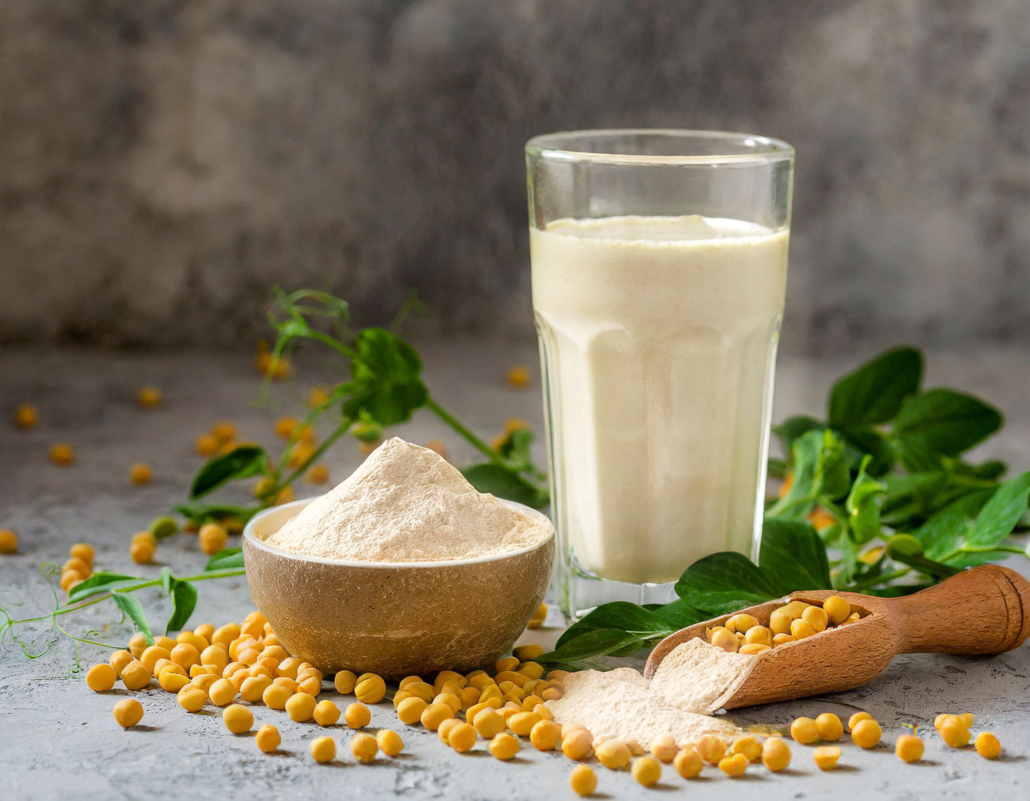
How Can the Biological Value of Pea Protein Be Increased?
How exactly you can increase the value depends, among other things, on how much of the food you consume and what other foods you combine it with. The goal is to cover as complete an amino acid profile as possible. Pea protein, for example, contains all essential amino acids. However, methionine (important for muscle maintenance) and the semi-essential amino acid cysteine (important for blood sugar regulation and the immune system) are not present in sufficient quantities.
Therefore, this deficiency must be compensated for to achieve a complete profile. Legumes like peas can usually be optimally complemented with grains. For example, rice protein has high amounts of methionine and cysteine and can thus compensate for the deficiency in peas. Conversely, rice protein has enough lysine to balance its deficiency in rice. Therefore, rice and pea proteins are a popular combination to increase biological value.
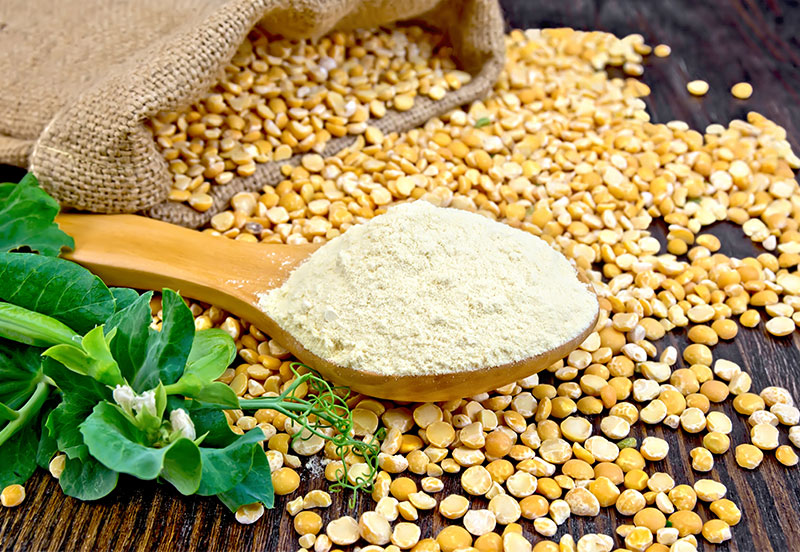
Is This Enough to Assess the Quality of Pea Protein?
Biological value still provides a good overview today but is overall too simple to do justice to the complexity of protein quality. It takes into account the proportion of amino acids contained but not how and where these are efficiently utilized by the body.
Since 2013, the Food and Agriculture Organization of the United Nations (FAO/WHO) has recommended the DIAAS (Digestible Indispensable Amino Acid Score) as a better evaluation method. This method considers not only the composition of amino acids but also their actual digestibility to the last part of the small intestine (ileal digestibility). This provides insights into how efficiently the converted amino acids can be used by the body.
When Is the Biological Value of Pea Protein Relevant?
For normal, healthy, and balanced nutrition, this value is usually not very relevant. However, it can provide a good overview of which foods can be best combined for a good protein composition. Athletes and bodybuilders, in particular, often use biological value to optimize their muscle growth.
In old age, the body can utilize proteins less efficiently – here too, it may be sensible to pay attention to their quality and usability. As with metabolic or other diseases that can lead to a protein deficiency, you should especially consult with your doctor in such cases.
High-Quality Pea Protein from naVitalo
We are specialists in plant-based food ingredients in wholesale. You can get the pea protein from our range in different versions, but always in the best quality. Feel free to contact us if you are looking for vegan ingredients for your production. You can reach us at Phone: +49 (0)208 880 264 00, E-mail: info@navitalo.com.
Sources (As of: 07.03.2024):
Netdoktor: Pea Protein Netdoktor
https://www.netdoktor.de/ernaehrung/lebensmittel/erbsenprotein/
National Library of Medicine: Protein and Amino Acids
https://www.ncbi.nlm.nih.gov/books/NBK234922/
The Current Situation of Pea Protein and Ist Application in the Food Industry https://www.ncbi.nlm.nih.gov/pmc/articles/PMC9412838/
Sugar in the form of glucose is the most important source of energy for our body. We are usually sufficiently supplied with it as we absorb it through our everyday carbohydrate-containing food. Adding sweetness to our diet is therefore unnecessary and, in the worst case, even harmful – but also very tasty.
More and more people are therefore looking for a sugar alternative so as not to harm their bodies and still not have to go without. Rice syrup is often chosen instead of sugar. Below we explain whether it really is a healthier alternative.
Whether rice syrup or industrial sugar: large quantities are never healthy. It doesn’t matter whether we consume it through sweets or as fructose in fruit. Excess sugar is stored in the liver and kidneys, converted into fat and stored in the body.
What is rice syrup?
As the name suggests, the syrup is made from rice. This is finely ground in the first step. The flour is then boiled in water and the coarse particles are filtered out. The remaining liquid is boiled down until it has a consistency similar to honey.
The finished rice syrup, is available in different shades of color. Depending on the quality and type of rice and the filtering process, it varies from water-white to a dark amber. Darker syrups usually have a stronger, malty-caramel taste.
Incidentally, so-called industrial sugar (also known as household sugar) also comes from plant sources – usually sugar cane or sugar beet.
Properties: Comparison of the two sweeteners
Both sweeteners are obtained from plants and are a tasty addition to various dishes. However, there are also some differences.
Consistency
Industrial sugar is most commonly used in dry form – for example as sugar cubes or granulated sugar. However, syrup can also be made from sugar cane or sugar beet. The consistency and color of rice syrup is similar to honey.
Calorie content
Rice syrup usually has just over 300 kcal per 100 g – around 100 kcal less than sugar.
Fructose content
Rice syrup instead of sugar – a good idea if you are fructose intolerant! This is because fructose is present in industrial sugar, but not in the sweetener made from rice.
Glycemic index
The glycemic index (GI) indicates how much the blood sugar level rises after consuming a carbohydrate-containing food. The higher the value, the faster the blood sugar rises. Sugar has a GI of 68, rice syrup 98, so you should be careful, especially if you are diabetic.
Flavor
If you want to use rice syrup instead of sugar, you should know that the former tastes less sweet. To achieve the same sweetness, you would therefore need a higher quantity. If this is exactly what you like and a slightly malty caramel note is enough for you, rice syrup may be the ideal alternative for you.
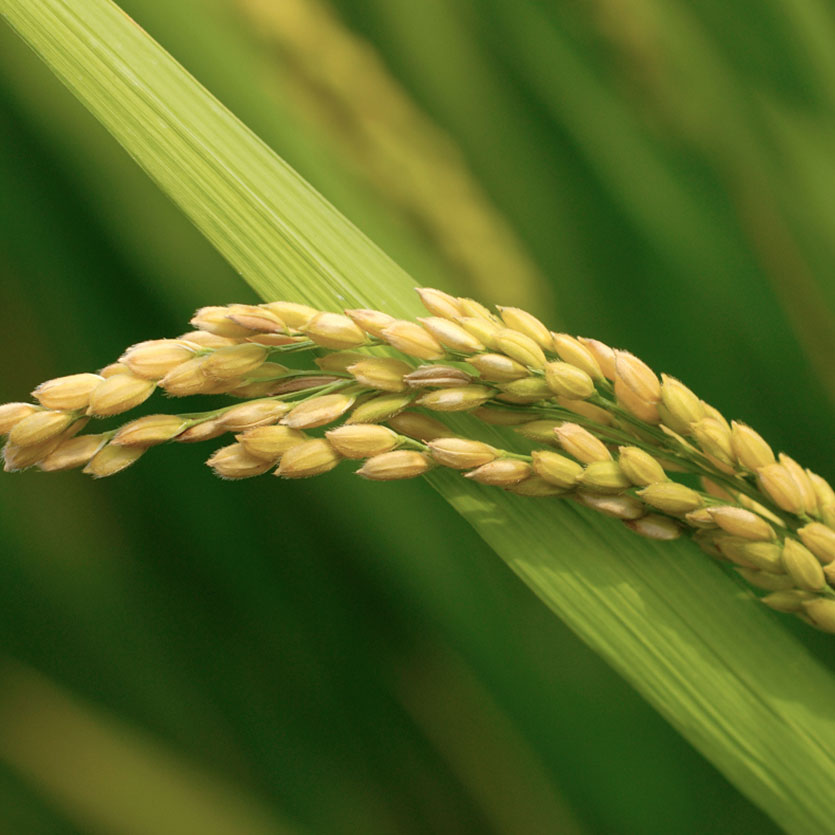
Use of rice syrup as a sugar substitute
Rice syrup has many applications and can be an ideal substitute for sugar both in everyday life and in industrial use.
Rice syrup is ideal
- for the production of baked goods and confectionery
- in yoghurt or porridge
- as a vegan alternative to honey
- in pharmaceutical products and vitamin supplements
- in sauces or dressings
However, bear in mind that it will affect the moisture balance of your recipe as it is not used in dry, crystalline form. You should therefore reduce the amount of other liquids.
Rice syrup instead of sugar: a good alternative – if the quality is right!
Let’s summarize: Rice syrup is not necessarily healthier than household sugar, but it does have some advantages over it.
It can be the right choice if you appreciate a mild sweetness with fewer calories or are looking for a fructose-free alternative.
A tip for buying: Ideally, choose a product in organic quality. That way you can be sure that no genetic engineering has been used.
We at naVitalo go one step further and subject our rice syrup to microbiological testing. In this way, we can offer you different quality levels that you can even use in baby food without hesitation.
By the way: Oat syrup or tapioca syrup are also tasty ways to add vegan sweetness to your products.
So if you are a food manufacturer looking for a vegan honey alternative, please contact us here.
Hemp is one of the oldest crops in the world. In the past, it was known primarily as a supplier of raw materials and a source of food – until it became associated with drug trafficking. Even today, this bad reputation is still attached to the hemp plant.
Foodstuffs made from the plant therefore do not seem very trustworthy to many people. Also the question whether hemp protein is unhealthy comes up again and again.
Properties of hemp protein
A look at the characteristics of hemp should help to clear up the prejudices. First and foremost, the drug cannabis is derived from plant species with higher THC content. This is the substance responsible for the intoxicating effect after consumption. Foodstuffs may (in Germany) consist exclusively of plants low in THC.
This also applies to hemp protein. These are legal, non-addictive and even consist of seeds that naturally contain no THC. A fact that may put your mind at ease at this point.
Of course, the non-existent intoxicating effect does not simultaneously rule out the fact that hemp protein is unhealthy. However, many other positive properties paint a different picture:
Amino acid profile
The basic building blocks of all proteins: these are amino acids. Eight of them are particularly important for the human body. So-called essential amino acids (EAA) are indispensable for us. Because our body cannot produce them itself, they must be ingested through food. Hemp protein contains all eight of these indispensable protein building blocks!
An absolute advantage, because these are among other things (!) Responsible for:
- Maintenance & building of muscle tissue
- Support of healing processes
- Supply of energy
- bone growth
- Metabolic processes
- Sense of satiety
- Mood and attention enhancement
The amino acid complex BCAA (Branched Chain Amino Acids) is also found in the vegetable protein. It consists of three of the essential protein building blocks mentioned above, namely: valine, leucine and isoleucine. This is especially interesting for athletes and sportswomen, because these branched-chain amino acids significantly accelerate muscle building.
Last but not least, there is a high percentage of arginine – another indication that hemp protein is not as unhealthy as it is said to be. It is a semi-essential amino acid – that is, one that can be formed by the body, but is not sufficient in the event of illness, for example. Then it must be added through food.
Arginine dilates the blood vessels and lowers blood pressure. Thus it is important for the prevention and therapy of atherosclerotic heart and vascular diseases.
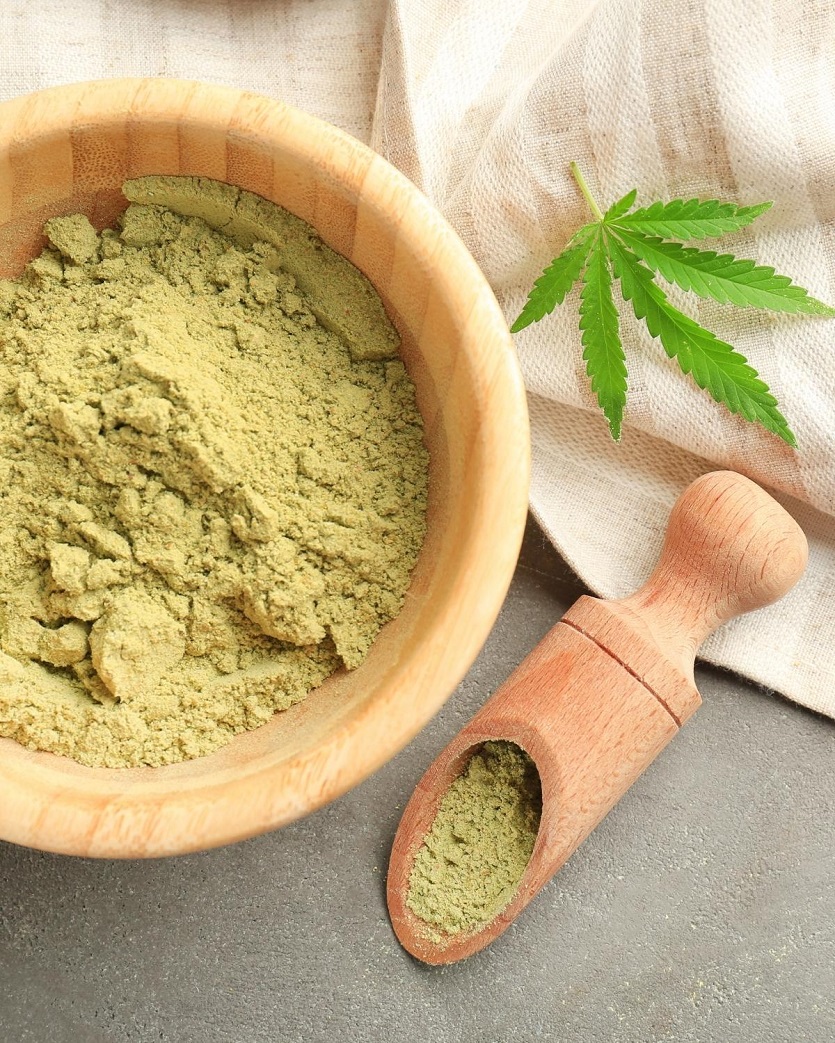
This is what Hemp Powder looks like.
Biological value
How fast proteins can be metabolized (i.e. converted to endogenous protein) is determined by the biological value. One orients oneself thereby at a value of 100, which corresponds to an egg and is considered high.
In principle, the value of animal proteins is somewhat higher than that of plant proteins. Hemp protein, for example, has a biological value of about 60.
But before you jump off now because this is too little for you: You can combine vegetable proteins with each other in an uncomplicated way. This way you can increase the biological value. (By the way, the amino acid profile can also be perfected in this way, if the amount of certain building blocks is increased in the process).
Hemp Protein: Nutrients
That hemp protein is unhealthy sounds very distant, if you take a look at the ingredients. In fact, the protein contains quite important of them:
Our body cannot produce the essential omega-3 and omega-6 fatty acids itself. They have a positive influence on cholesterol levels. Hemp protein is a good source of these fatty acids.
The dietary fibers relevant for a healthy diet can also be found in the protein. These are important for healthy digestion. They also slow down the absorption of cholesterol and sugar into the blood.
In addition, oat protein contains zinc, iron, important vitamins (B1 & B6) and minerals.
Compatibility
The vegetable protein is considered to be very digestible. Overall, it has a very low allergenic effect. Even with intolerances hemp protein is anything but unhealthy: it is lactose and gluten free.
When is hemp protein unhealthy?
In principle, rather healthy properties can be attributed to the vegetable protein. But as with everything, the quantity is just as crucial as a varied diet.
Hemp protein becomes unhealthy when you overdo it. But this is basically true for all proteins. The human body can absorb a certain daily amount without harm. Exactly how much that is depends on the individual and, for example, on your weight. Before taking protein in the form of hemp protein powder, pea proteins or even animal protein sources, you should therefore inform yourself in detail. Too much of a good thing in this case can mean damage to the liver and kidneys.
In addition, you should pay attention to the origin. In that your hemp protein is not unhealthy or harmful to health, you can only be sure if you trust the producer. For example, we at naVitalo make sure that all raw materials are free of genetic engineering. In addition, these are microbiologically controlled and correspond to the best BIO quality. No matter where you get your vegetable proteins: These are properties that you should absolutely pay attention to.
Plant-based substitutes for industrial sugar are becoming increasingly popular. On the one hand, many people want to do without the artificially produced sweetness for health reasons. But also those who like it a little milder are well served with an alternative.
There are now many different vegetable sweeteners, including tapioca syrup. This is considered a vegan option to replace honey. Thereby it brings some advantages with itself, which we would like to introduce to you in the following.
How is the syrup made?
The sweetness is made from the cassava root. This grows mainly in tropical regions. The term tapioca explicitly describes the starch extracted from the plant tuber and can be processed into various products.
There are different ways of producing syrup. In each of these, the carbohydrate compounds are broken down into short-chain molecules, which gives the syrup its slightly sweet taste – tapioca is originally largely tasteless. The splitting is achieved either by chemical or enzymatic processes.
Depending on the manufacturing process, syrups can differ in taste, consistency and nutritional values. The color can also vary: Typically, tapioca syrup is as clear as water, but is also available in a light yellow hue. The darker the hue, the stronger the flavor. However, it is basically known for its rather mild sweetness.
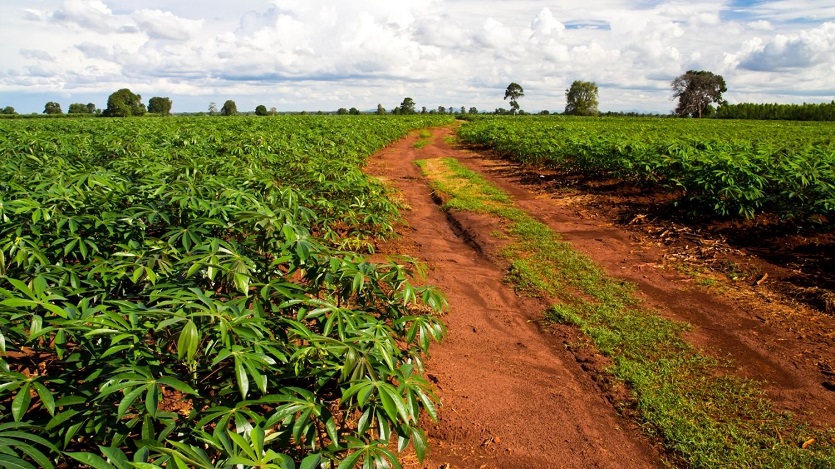
This is a Cassava Plantanation.
Advantages of tapioca syrup
Depending on your perspective, the syrup has different benefits. For example, if you are avoiding animal products, it is a good alternative to honey. However, it may also be worthwhile for you to resort to it for health reasons:
Tapioca is free of fructose and gluten and therefore optimal for corresponding intolerances and allergies. In addition, the syrup is considered easily digestible and contains almost no fat.
Tapioca syrup can also hold its own in a direct comparison with household sugar. Depending on how it is made, it can have between 165 kcal and 326 kcal, while sugar is around 400 kcal.
So is the vegetable syrup healthy?
Caution is always advised when classifying whether something is considered healthy or unhealthy. After all, it always depends on the overall diet. At least tapioca syrup brings many benefits and can be a very good alternative to sweetening with sugar.
Nevertheless, we would like to point out: It is still a sweet additive that you should enjoy in moderation and not in masses.
How to use tapioca syrup
Another advantage of tapioca syrup: the many ways you can use it. Basically, you can use it for everything for which you would have otherwise used honey or sugar.
For example, it can be used in
- hot and cold drinks (e.g. tea or lemonade)
- Smoothies and juices
- Muesli and muesli bars
- various desserts
- baked goods and snacks
Another advantage in use: you can use the syrup very well for browning and caramelizing. In addition, adding tapioca syrup instead of sugar makes beaten egg whites especially creamy.
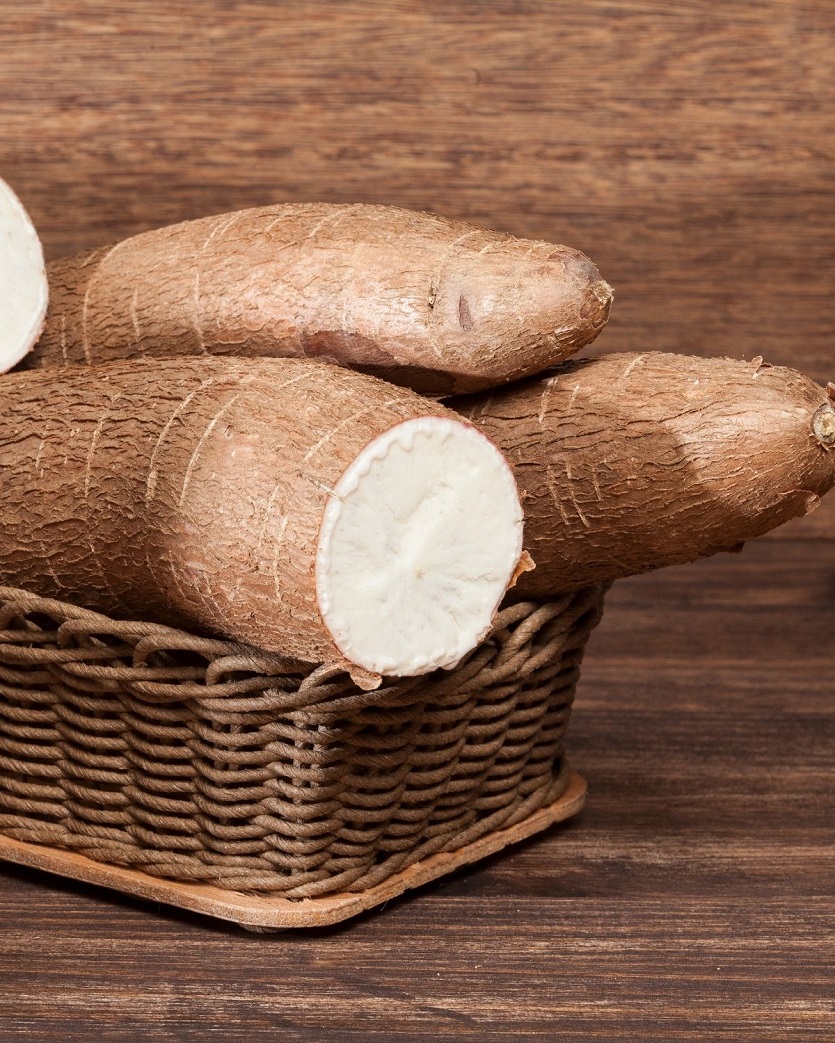
Cassava Roots for production of Tapioca Syrup.
This is what you should look for when buying
With vegetable products, you are always well advised to use organic quality. It is best to make sure that the tapioca syrup has been produced using natural and GMO-free enzymes.
Depending on the intended use, you should also check if the consistency is suitable for your purpose.
If tapioca syrup is not the right product for you, there are many other alternatives such as oat syrup and rice syrup. You might also be interested in our blog post Rice syrup: healthy alternative to other sweeteners?
If you work in food manufacturing and are looking for alternative sweeteners, we are also available for in-depth consultation. We at naVitalo are specialists in food ingredients made from tapioca, but also from oats, rice and other cereals. We attach great importance to high-quality, BIO-certified and environmentally friendly products. Interested? Then feel free to contact us.
There are many reasons why people limit their meat consumption. These include health aspects as well as animal welfare and environmental protection. The moral dilemma: giving up meat for good reasons and liking the texture and taste are two different pairs of shoes.
The demand for plant-based alternatives is therefore growing all the time. But here, too, consumers are choosy. In the end, many former meat lovers measure the product against real meat.
As a manufacturer, it means achieving the appropriate consistency in addition to taste. Find out what oat protein textures have to do with this and why they are considered a good substitute below.
What are oat protein texturates?
In order to give plant proteins a meat-like texture, they are processed into so-called texturates. In other words, they are changed in texture and consistency.
To do this, you put oat protein as a viscous mass into an extruder. Under great pressure and heat, this is pressed through an opening. It then cools and hardens. You can determine how the final product looks by shaping the opening.
The textured oat protein can finally be soaked in water and processed further. This produces meat-like structures, which are a good basis for vegan nuggets or cutlets, for example.
Protein texturates can be found in common supermarkets, for example, as an alternative to minced meat. They are often made from soy. However, oat protein is often the better choice, as we explain in the next step.
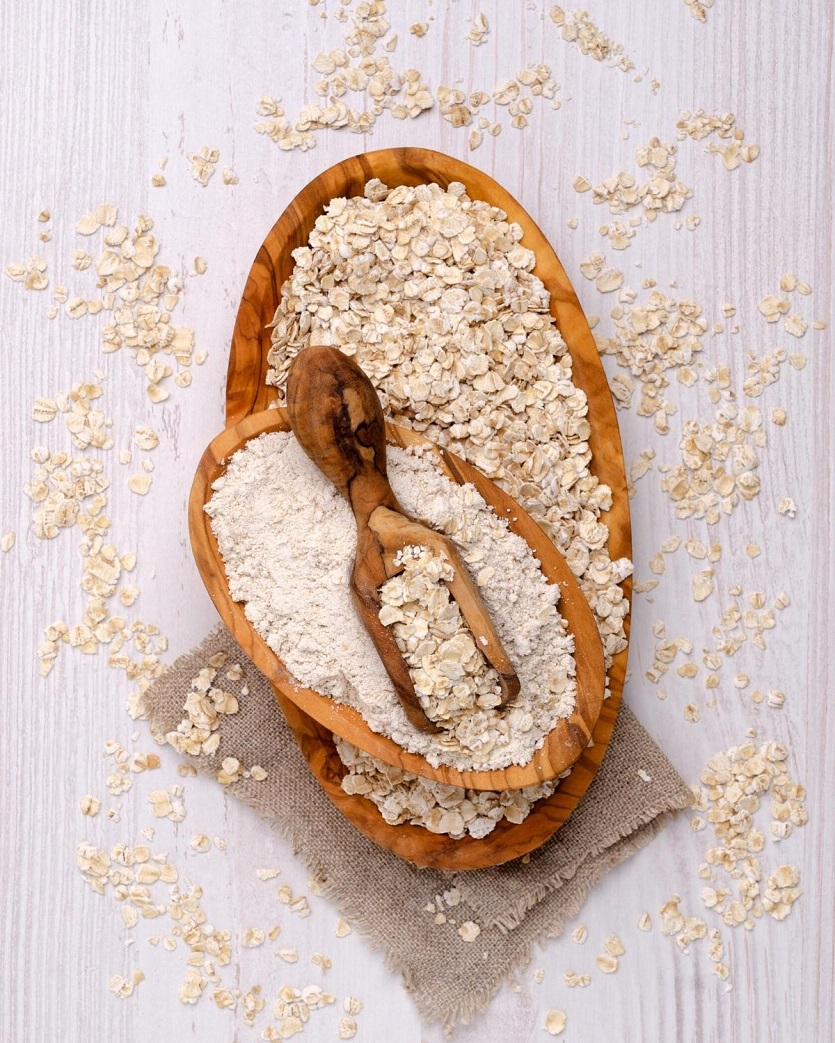
Oat Protein Powder.
What are the advantages of oats as a meat substitute?
With so many plant-based alternatives to choose from, why should it be oat protein? In fact, the grain brings many benefits. So it’s no wonder that it’s becoming increasingly popular in meat substitute products.
One reason is that demand for soy products is declining. One reason is that many people are allergic to it. This mostly affects birch pollen allergy sufferers, as a cross-reaction can occur with them. On the other hand, the cultivation of soybeans is associated with genetic engineering.
Here, oats are clearly superior: This is considered very well tolerated and can be grown locally. As a result, it has a good carbon footprint.
But the grain is also impressive from a health perspective:
Oat fiber contains a lot of protein, healthy fats and antioxidants. Above all, however, oat protein texturate is a good source of iron – even better than steak, for example.
A high amount of dietary fiber ensures that you stay full for a long time after eating it. The soluble fiber beta-glucan is also particularly helpful in lowering blood sugar and cholesterol levels.
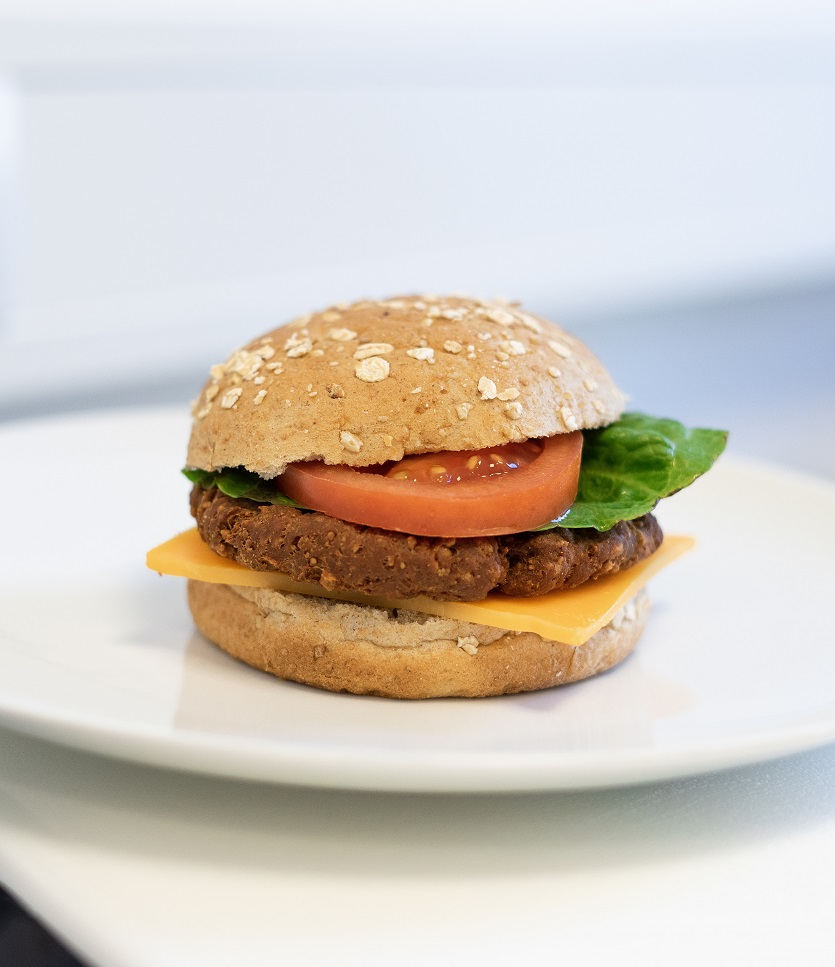
Burger with Oat Protein Texturates.
Protein texturates from other plant proteins
Oat protein texturates don’t appeal to you? Fortunately, there are other alternatives that can be made into meat substitutes.
Pea protein is another popular plant-based alternative used for this purpose.
Basically, before choosing the right product, you should make clear which properties are particularly important to you. We attach great importance to BIO quality, sustainability and the use of GMO-free ingredients. Therefore, naVitalo has specialized in the production of appropriate products.
With our assortment, we mainly address food manufacturers. If this applies to you and you would like to receive more information about oat protein, please contact us.
Oats are appearing more and more frequently on menus. There are good reasons for this, because the grain is very versatile. For example, it is convincing in the form of oat drink, as a meat substitute or in breakfast cereals. In addition to the wide range of applications, however, oats are particularly convincing in that they are healthy – and not least because of beta-glucan.
In this blog post, we will devote ourselves entirely to this oat-specific dietary fiber. You will learn below why it is so healthy and how you can use it in food.
What is oat beta-glucan?
Dietary fibers are indigestible carbohydrates. Beta-glucan is found in some yeasts, mushrooms, algae and cereals. Depending on the source of origin, they have different properties.
Oats play a major role here. Many positive characteristics are attributed to oat beta-glucan. The water-soluble dietary fiber is particularly popular because of its cholesterol-lowering effect. However, there are definitely other benefits that make its consumption recommendable.
Health effects of oat beta-glucan
Various research results recommend a daily intake of about 3 g of oat beta-glucan. Thus, the dietary fiber is said to be able to have a positive influence on the human body.
Particularly noteworthy are the following properties:
Cholesterol-regulating
Oat beta-glucan lowers the level of cholesterol in the blood and helps maintain a normal level. This simultaneously reduces the risk of coronary heart disease.
Blood sugar level is lowered
You can also improve the level of your blood sugar with the intake of dietary fiber. These can help in reducing the spikes in blood sugar after eating.
Benefits for the stomach and intestines
Dietary fiber stimulates intestinal motility and therefore digestion. When swollen, these become a jelly-like mass. This mass covers the intestinal mucosa and protects it. Harmful substances are bound and excreted. In addition, oat beta-glucan has a soothing effect on the stomach.
Feeling of satiety
Due to the swelling of the dietary fiber, the food stays longer in the stomach. The stomach is also stretched. This leads to a longer feeling of satiety and can thus also contribute to weight reduction.
Oat fiber as a supplier: Use in foods
The question remains, how you can take in the so healthy dietary fiber through the daily diet. Fortunately, this is not a problem. In principle, the consumption of oatmeal or bran, for example, is suitable for this purpose.
Alternatively, you can also consume oat beta-glucan via oat fibers. It is a natural source that can be prepared in different ways. That is why it is a popular additive among food manufacturers.
The fibers are available in powder form. This makes them ideal for further processing. They are often used, for example, as follows:
As a binder
Because of their strong water-binding properties, oat fibers have a thickening and stabilizing effect. This gives sauces, soups and other liquids a creamy consistency.
In baking
Add oat beta-glucan in the form of fiber to your dough and it will become fluffier. If you add the powder to your shaped bread, it will also have an attractive appearance: Oat fibers do not turn brown in the oven, but retain their white color.
As a guarantor of freshness
Making muffins and cakes fresher and longer lasting – this is also possible with oat fiber. The powder ensures improved moisture management.
For beverages
Since oat fiber powder is highly soluble, it makes your drinks smoother. This way, you can also increase the beta-glucan content in oat drinks and other liquids.
As a stabilizer
You can use the fibers alone or in combination with other starches and so-called hydrocolloids as a stabilizer.
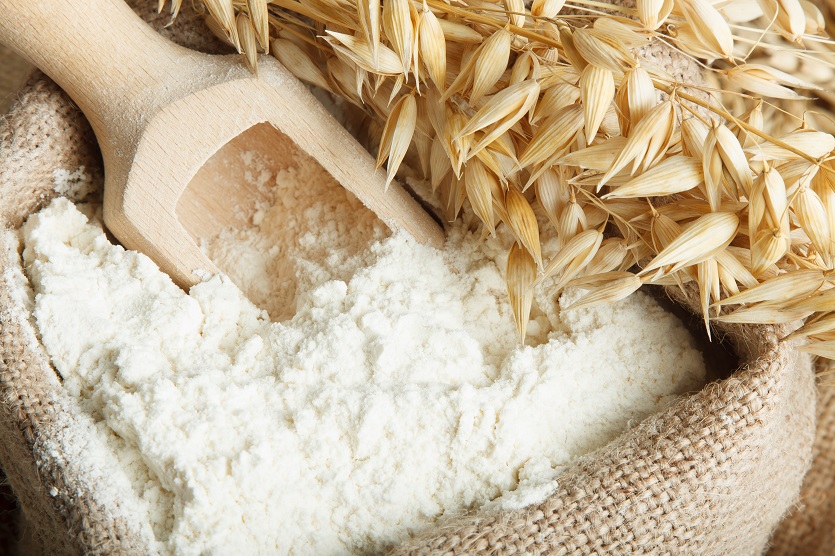
You can find Oat-Beta-Glucan in Oat flour.
Beta-glucan from high-quality oat sources
No matter which oat product you choose to ingest or add to your food beta-glucan: It should be made from high-quality grains.
But what exactly does that mean? For naVitalo, the focus is on microbiological cultivation without genetic engineering. As a specialist in plant-based foods made from purely natural ingredients, we pay particular attention to this.
For our products such as oat syrup, oat drink powder or oat protein we therefore only use appropriate grains.
You are a food manufacturer and have questions or comments? Then contact us! We will be happy to advise you in detail.
Rice is a cereal with many advantages. Above all, you benefit from the many possible applications. Whether as a cooked grain, vegan rice drink or protein powder – you have a few options open to you.
We would like to go into a little more detail on two of them in this blog post: Syrup powder and maltodextrin from rice are often used, especially in food production. Find out exactly how they are used there and what the benefits are below.
What are rice syrup powder and maltodextrin?
Rice naturally contains a lot of starch. This is the basis for the production of both products:
Maltodextrin is produced by the splitting (hydrolysis) of starch into sugar. This happens during a biochemical process and by special enzymes. Often, the dual sugar is obtained from corn starch, but rice is also an excellent choice. Maltodextrin is one of the carbohydrates. Purchased ready-made, you get a product with a powdery consistency.
The production of rice syrup powder also uses an enzymatic process. In this process, the starch is liquefied, saccharified and dried again by spraying. Here, too, you get – as the name suggests – a powder.
Both products are made from 100% rice. So it sounds pretty similar up to this point – but it is above all in the properties and intended use that decisive differences become apparent.
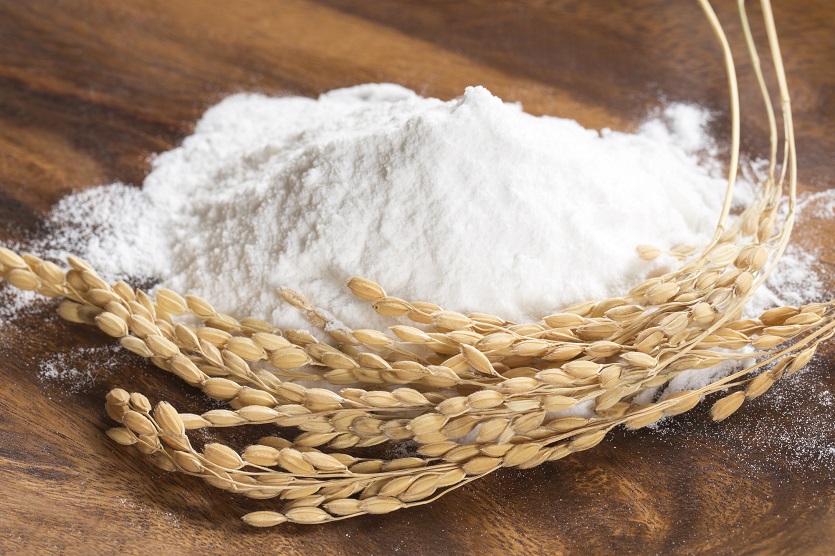
Syrup Powder and Maltodextrin from Rice.
Advantages and properties
Maltodextrin and syrups can be found in the ingredients of many common foods. These include baked goods, cornflakes, frozen products and even medicines. Thereby they convince with quite different characteristics:
Maltodextrin from rice is neutral in taste.
Similar to pure dextrose, the carbohydrate passes quickly into the blood via the intestines. This means a rapid supply of energy. This is particularly positive for sportsmen and sportswomen. However, because blood sugar levels rise quickly after consumption, diabetics should avoid maltodextrin.
In addition, it is water-soluble and gives liquids a creamy consistency and serves as a foam stabilizer. It is also used as a carrier for flavors.
Maltodextrin is also a proven means of increasing calorie intake. That is why it is also used in the medical field for people who are severely underweight.
Rice syrup powder, in contrast, tastes slightly sweet.
It assists in the binding process, enables improved elasticity and plasticity. It also reduces sugar crystallization.
Both products are gluten-free and therefore suitable even in case of intolerance.
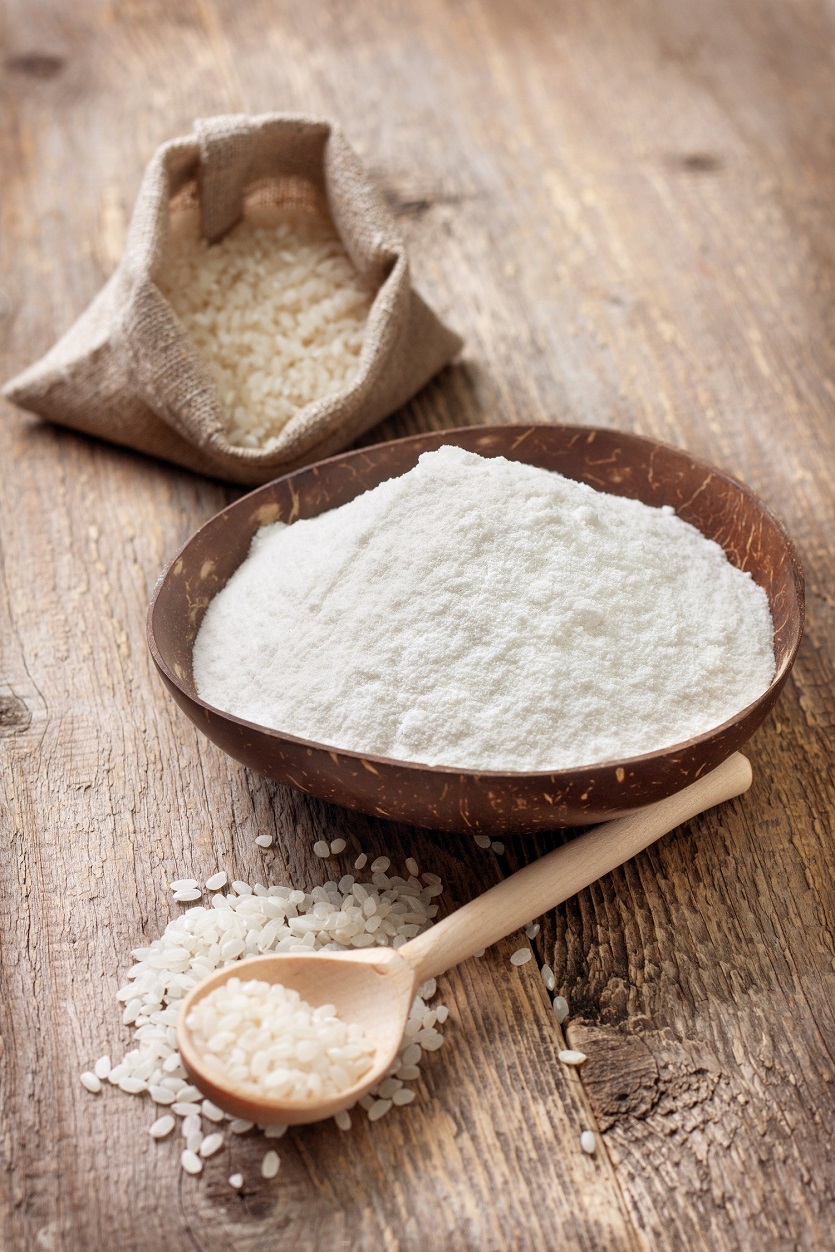
Rice Syrup Powder and Maltodextrin with a lot of benefits.
Maltodextrin and rice syrup powder in the food industry
The properties of both rice products can be deduced: Both are used for better consistency. However, syrup powder is mainly used to sweeten food.
Since both products are purely vegetable, they are often found in vegan foods. But food manufacturers don’t just rely on them there. Both maltodextrin and rice syrup are used in:
- Baby and sports foods
- Baked goods and desserts
- Beers and alcoholic beverages
- Spices, spice mixtures, flavors
- Sauces and dressings
- beverage powders
- energy drinks
- frozen products
- medicines
What to look for when buying rice products
When using maltodextrin or syrup powder made from rice, it is important to pay attention to the quality of the grain used. There are still areas where rice is grown on soil that contains contaminants. Arsenic, which is found in groundwater, is often absorbed by the plant in the process. When consumed in large quantities, this becomes a problem – especially for children.
Therefore, be sure to use rice or rice products from microbiologically controlled grains. We at naVitalo also rely exclusively on cultivation without genetic engineering. It is important to us that you, as the producer, receive a product that you can process without worry. Therefore, if you are looking for maltodextrin or syrup powder made from high quality rice, contact us. We will also be happy to answer your questions.
More and more people are replacing cow’s milk with plant-based alternatives. The focus is not always on a vegan lifestyle: animal welfare, the environment, health … there are many reasons to turn to plant-based drinks.
Reason enough for common grocery stores to include different varieties in their assortment. Here you will also find oat drinks (often incorrectly referred to as oat milk) as standard. Not yet so widespread, but quite practical is oat drink powder. What advantages this brings with it, is the subject of this blog post.
What is oat drink powder?
The difference with the oat drink in the tetra-pack is primarily in the application. With oat drink powder, you get an alternative to mixing it yourself. The product is created by subjecting oats to a diffusion process. During this process the cereal gets the changed consistency. Depending on the manufacturer, the procedure and the addition of other ingredients may vary somewhat. However, as a rule, it is still a natural product, consisting primarily of oats.
You can mix the resulting powder with water. This will give you an oat drink that is the same as the one you get in the supermarket.
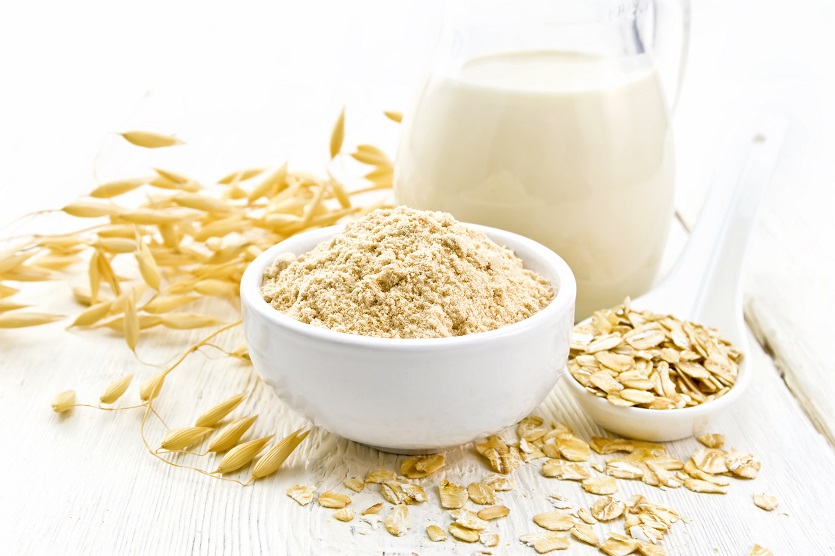
Oat Powder in a Bowl
Mix oat drink instead of buying liquid: What are the advantages?
But why should you resort to oat drink for mixing when you can get the time-saving alternative in any grocery store or wholesale? In fact, there are several arguments in favor of oat drink powder:
You have control over how intense the taste should be. Since you mix the drink yourself, you can adapt it to your individual preferences.
Especially when using large quantities, for example as a food manufacturer, you act environmentally conscious. With oat drink powder, there is much less waste for the same amount of the drink. In addition, the grain can be grown regionally, saving unnecessary import routes.
When shopping, you also benefit from not having to carry heavy: With one can of oat drink powder, you stir about five liters of the drink.
Other applications of oat drink powder
In fact, you can vary the use of the powder – another advantage over the purchased liquid. Instead of using it exclusively to mix oat drink, many people use it as a vegan alternative to coffee creamer.
In addition, you can also use it to enhance cereal, yogurt, or in baking. Since the powder has a slight sweet note, you can add a delicious flavor to your dishes.
Oat milk powder is especially interesting for food manufacturers: it is the optimal milk substitute product in vegan versions of ice cream, desserts and chocolate.
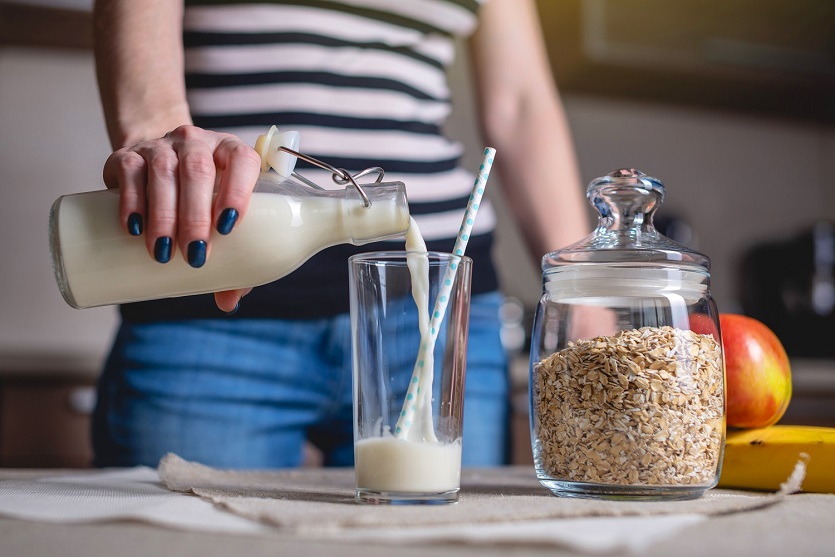
Oat Milk out of Powder
Further advantages of and purchase tips for oat products
Basically, oat convinces with its many positive properties: It is generally considered to be very easy to digest. However, people with lactose intolerance are particularly well served by the grain – it contains no lactose. In addition, oats contain a variety of essential amino acids, minerals and vitamins that are important for the human body.
When buying products made from oats, you should pay attention to high quality. For example, we at naVitalo attach great importance to sustainability and the absence of genetic engineering. To ensure that the above benefits really end up in the final product, our oats used are microbiologically controlled. If you are food manufacturer looking for appropriate products, contact us gladly.
Oat drink powder is not right for you? Maybe you would like to try rice drink powder – or you can read more about it first in our blog post: Rice drink powder: Benefits and application of the plant-based milk alternative.
When looking for vegan proteins, you will always come across rice proteins. No wonder, after all, these are considered one of the best alternatives to animal products. This is due, among other things, to their advantageous amino acid profile.
What the composition of the protein building blocks in rice protein looks like and what positive effects it has, you can read here.
What are amino acids and why are they important?
To make it clear how to value the properties of rice protein, let’s first briefly summarize the basics:
Amino acids are the basic building blocks of all proteins. A total of 21 different ones can be found in the human body. These can be divided into three groups: non-essential, semi-essential and essential amino acids.
The former are produced by our body on its own. This also applies to semi-essential protein building blocks. However, in case of illness, injuries or during growth, an additional supply via food is often advisable.
The last group is particularly important: essential amino acids (EAA) are indispensable for the human body. Unlike the other building blocks, however, it cannot produce them on its own. Our task is therefore to absorb them through food.
How important these special building blocks are, you will learn in the next section, because …
These amino acids are contained in rice protein
… all eight essential amino acids are found in rice protein. A clear advantage of the amino acid profile. For this reason, vegan protein is considered a valuable alternative to animal products.
Functions of the essential protein building blocks
These basic building blocks are indispensable mainly because of the functions they perform. The essential amino acids contained in rice protein are responsible for the following processes, among others:
Leucine
- Maintenance & building of muscle tissue
- New formation of proteins in muscles & liver
- Inhibition of the breakdown of muscle proteins
- Support of healing processes
- Important energy supplier
Lysine
- Muscle building
- Build-up of other amino acids
- Bone growth
- cell division
- wound healing
Methionine
- participation in metabolic processes
- reduces colonization of bacteria in the urinary bladder
- supports detoxification
- precursor of taurine, cysteine and glutathione
Phenylalanine
- Precursor of dopamine, adrenaline, noradrenaline
- Increases attention
- Counteracts depressive moods
- Relieves pain
Threonine
- regulates fat balance and liver function
- Important for the nervous system
- Component of collagen and elastane in the skin
Tryptophan
- Precursor of serotonin
- Increases mood, well-being and performance
- Supports formation of melatonin and niacin
- Reduces hunger pangs
Valine
- Regulation of blood sugar
- Supports protein formation
- Faster absorption of all amino acids in muscles and liver
Histidine
- Growth of tissue repair
- Important for protection of nerves
- Converted to histamine
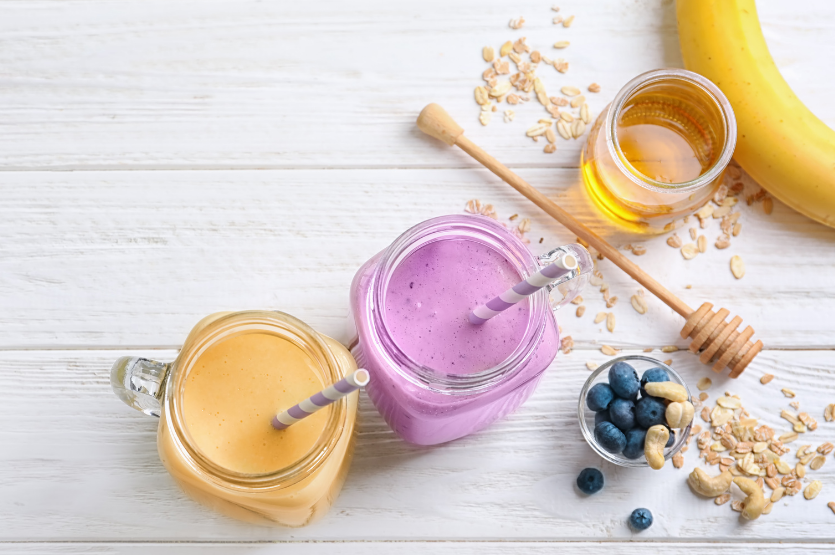
Rice Protein Shakes with Protein
Branched chain amino acids in rice protein
The essential protein building blocks valine, leucine and isoleucine also form a branched-chain amino acid complex. This is abbreviated to BCAA (Branched Chain Amino Acid). Unlike most other building blocks, this complex is not metabolized in the liver.
Especially for athletes and sportswomen BCAA is important. Together, the complex is responsible for accelerating muscle growth and preventing breakdown.
A deficiency of the amino acids can make itself felt. In this case, you feel sluggish or suffer from colds more often.
Here, too, the rice protein amino acid profile can score: It contains quite a high amount of these branched-chain protein building blocks.
The semi-essential amino acid arginine
Also part of the amino acid profile of rice protein: a larger amount of arginine. It can be used as a preventive measure or in addition to therapy for cardiovascular diseases caused by atherosclerosis. These are those in which there is storage of cholesterol and other fats in the blood vessels.
In general, arginine is known for its positive effect on blood vessels. This is due to the fact that it is a precursor of the messenger substance nitric oxide, which has a vasodilating effect.
In addition, the amino acid can lower blood pressure and strengthen the immune system.
The perfect amino acid profile with rice protein in combination
Because all essential amino acids are found in rice protein, it is considered a very valuable source of protein. It is therefore particularly noteworthy among the plant-based alternatives. Nevertheless, there is still room for improvement: The amount of building blocks is lower than in whey protein (also: Whey protein), for example.
For a perfect amino acid profile, you can easily combine different vegan proteins! Rice, oat, pea and hemp protein complement each other very well. All three contain essential amino acids in varying amounts. Together, they can definitely keep up with animal proteins.
Pea protein, for example, has a higher value of lysine. This makes it a good complement to rice protein. This in turn can serve with a good tryptophan content.
At naVitalo you can get all the above proteins. Our assortment is mainly aimed at food manufacturers who attach great importance to high-quality food in BIO quality. All our products are plant-based, microbiologically controlled and free of genetic engineering. Do you have any questions? Contact us for a detailed consultation.
